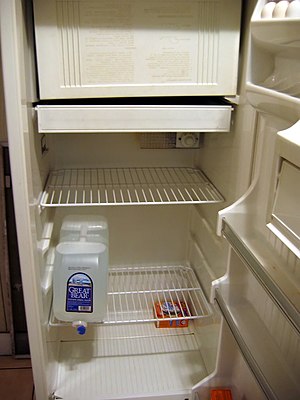- "The best way to spend your money is to spend it on time, not on stuff." http://su.pr/2tr5iP #
- First bonus by stock options today. Not sure I'm impressed. #
- RT @chrisguillebeau: US border control just walked the train asking "Are you a US citizen?" Native American guy says: "One of the originals" #
- @FARNOOSH My credit score is A measure of my integrity not THE measure. in reply to FARNOOSH #
- I'm listening to a grunge/metal cover of "You are my sunshine" #
- There's something funny about a guy on reality TV whining about how private he is. #LAInk #
How to make room for a paying lodger

- Image via Wikipedia
A spare room in your home is an opportunity to boost your income. Imagine how much extra cash you could make by offering that space to a rent-paying tenant. You can start getting things ready by creating the necessary space right now. Our guest blogger, Big Yellow Self Storage, shows you how in these five simple steps.
1. What needs to go? Take a good look around your spare room (and the rest of your home, while you’re at it). Decide what you’re happy to part company with and what you want to find a storage solution for.
2. Sell, donate or trash. For anything with a monetary value, get selling. Try online auctions, your local classified ads, boot sales(ed. That’s a flea market or swap meet for those in the U.S.) – anything that offers a cheap and quick way to raise cash. Alternatively, give your unwanted but perfectly serviceable items to charity. As a last resort, put them out with the trash or take them to a recycling centre.
3. Decide what sort of storage solution you need. For those items that you’re not getting rid of, you’ll need some form of storage facility. And, depending on what those items are, this could be a garden shed, a loft, a garage or a unit at a secure, temperature-controlled storage site.
4. Prepare your items to go into storage. Flat pack self assembly furniture and keep the fixings close by in a small bag. Coat wood and metal with varnish and rust protector respectively. Keep mattresses in bags available at DIY stores. (Change the bag every year). Use a wardrobe to store clothes, shoes, bags and bed linen – its small footprint will give you loads of hanging, stacking and shelving space. Be aware that books can get really heavy. Use lots of small boxes instead of fewer large ones and list their contents on the visible sides.
5. Get ready to welcome your lodger! All that remains now is to prepare and advertise your spare room – and start earning money!
For further information about storing just about anything and to find out more about storage options, visit Big Yellow for Self Storage.
Charity is Selfish
I try to give 10% of my income to charity. I don’t succeed every year, but I do try.
I don’t give because I’m generous. I give because I’m selfish.
If you give to charity, you are too.
I’m not talking about people who give to charity strictly for the tax deduction, though that is selfish too. I’m referring specifically to the people who give to charity out of the goodness of their hearts.
If I give a thousand dollars worth of clothes to a homeless shelter, I get a warm fuzzy feeling knowing that I helped people stay warm.
If I send $100 to the Red Cross for whatever terrible disaster happened shortly before I made the donation, it makes me feel good to have contributed to saving those lives.
The put-the-inner-city-kids-on-a-horse thing we do? Makes me happy to get those kids into a positive situation.
Donating blood? Yay, me! I’m saving lives!
While it’s nice to help other people, that’s not the ultimate reason I’m doing it. I do it because it makes me feel good about myself to help other people, particularly people who–for whatever reason–can’t help themselves.
That’s the basis of altruism. It’s not about helping others, it’s about feeling good about helping others.
The truly selfish, the evil dogooders, are the ones who want to raise taxes to give it away as “charity”. They get to feel like they are doing something and helping others while not actually contributing themselves and, at the same time, stealing that warm fuzzy feeling from the people who are providing the money to start with.
Evil.
Charity has to be done at a personal, local level or the benefits to the giver are eliminated while the benefits to the receiver are lessened. Bureaucracy doesn’t create efficiency.
For the record, if it’s taken by force, by tax, it isn’t charity. Charity cannot be forced. Forcing charity is, at best, a fraudulent way for petty politicians, bureaucrats, lobbyists, and activists to feel they have power over others.
Again, evil.
Crying is for Winners
Have you ever seen a kid come off a wrestling mat, crying his eyes out because he lost?

Often, that kid will get told to be tough and stop crying.
That’s wrong.
I’m not opposed to teaching kids not to cry under most circumstances, but just after an intense competition, I love it. It’s the best possible sign that the kids was pouring his soul into winning. It means he was trying with everything he had.
It means he is–or will be–a winner.
When a kid, particularly a boy in a tough sport, is crying, you know he’s going to try harder and do better next time.
For all of the “tough guy” ability it takes to succeed as a wrestler, I’ve never seen another wrestler teasing the crier. They’ve all been there. Wrestling is a team sport, but you win or lose a match on your own. When you step out in front of hundreds of people and spend 3 to 6 minutes giving every ounce of everything you have to give, only to find it’s not good enough, you’ll often find you don’t have the final reserve necessary to control your emotions.
This is different than a kid crying because he lost a game, just because he lost. Some kids feel entitled to win anything they do, regardless of the effort they put it. That’s also wrong.
Crying at a loss is okay after putting in maximum effort and full energy, not because the dice went the wrong way.
Repair Plans, Appliances, and Rancid Meat…Oh, My!

- Image via Wikipedia
We recently had our annual barbecue. (For the purists, I am Minnesotan. Barbecue means “cooked over fire”.) Due to massive scheduling conflicts, it was a bit smaller than normal; only about 20 people came. At least 10 other people RSVP-ed that they were going to make it, but didn’t. Grr.
Naturally, we had food for everyone said they would be there and enough for half of the people who didn’t say anything, since Minnesotans don’t RSVP well. That translates to a lot of leftovers. No problem. After all, leftover ribs are hardly a punishment.
Sunday morning, we woke up to find that our refrigerator was happier at room temperature than the standard “cold”. We didn’t know it at the time, but the defrost unit was borked, so the cold air couldn’t circulate from the freezer to the refrigerator. Bye-bye leftovers. Hello, Mr. Repairman. We needed an excuse to clean out the fridge, anyway, but not at the price of my beautifully seared meat! (Sadness strikes.)
Monday evening, the repairman came out, worked for 2 hours and left a functional refrigerator and a $240 invoice in his wake. Thankfully, we are on the appliance repair plan through the gas company. We pay $26.40 per month to cover repairs to our range, water heater, furnace, drier, sewer main, and refrigerator. The first four items are standard, the final two are options that cost extra.
We originally got on the plan for the sewer main. We had a tree whose roots grew into the main and clogged it every year. A backed-up sewer main is a crappy way to wake up. Getting that snaked to the street cost $200 per year. At the time, without the refrigerator, the plan cost about $12 per month. One $200 call-out more than paid for the plan for the year. That was easy math. Now, our 20 year old refrigerator has been repaired twice in the last year, giving us $500 worth of repairs for $316.80. I would like to take this time to thank all of the people with reliable appliances for subsidizing my repairs.
My furnace, drier, and range are all reasonably new and shouldn’t need repairs any time soon, but the refrigerator and sewer main have paid for the plan themselves, several times over.
Should you get a similar plan? If your covered appliances are more than 4-5 years old, I would consider it. If they are more than 10 years old, I wouldn’t hesitate at all. Repairing quality appliances is cheaper than replacing them, especially when the repair cost is paid monthly and subsidized.
Do you use a service plan?
A Bit of Christmas Magic

On Thursday, my wife left with my kids and dog. I had to work all day on Friday, so she took off to get an early start on Christmas at my brother’s house. I followed Saturday morning.
Two nights with no whining, and a bed to myself.
Friday afternoon, my wife called to tell me about her day.
When she got to my brother’s, she took her tailgate down to get the suitcases out of the back of her truck. She left the plastic container full of presents in her truck, since we’d be exchanging presents at my parent’s house nearby.
Friday morning, she left to feed her shopping addiction for a few hours.
When she got to the giant store that had our new car seats on sale, she discovered that she had neglected to put the tailgate back up on the truck when she unpacked. This was the box that held most of our budgeting overspend.
Gone.
When she called me, she was retracing her steps, hoping to find the box.
I was upset.
She didn’t find the box on the side of the road.
Gone.
Normally, this would be a strong object lesson in the futility of rampant consumerism. A lot of zen-like “the stuff you own is fleeting”, amidst the wailing of children who are discovering that their Christmas presents evaporated in a ditch somewhere.
Somebody found the box. I don’t know who.
Whoever it was, opened the box and saw the tears of small children inside. She read the name tags and, amazingly, recognized enough of the first names to place the family.
Keep in mind that I live more than 100 miles away, and moved out of the town 15 years ago.
This anonymous Christmas elf brought the box into a nearby gas station, and asked them to call my parents, since the names on the tags matched those of my parents’ grandchildren.
Everything was still in the box.
Everything was still intact.
Anonymous Christmas Elf saved Christmas for my family
.


